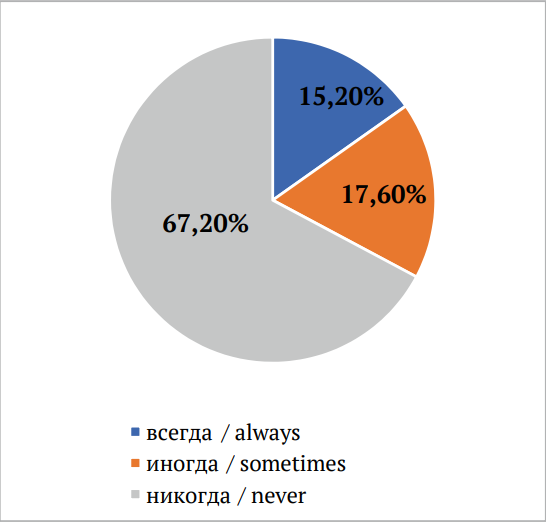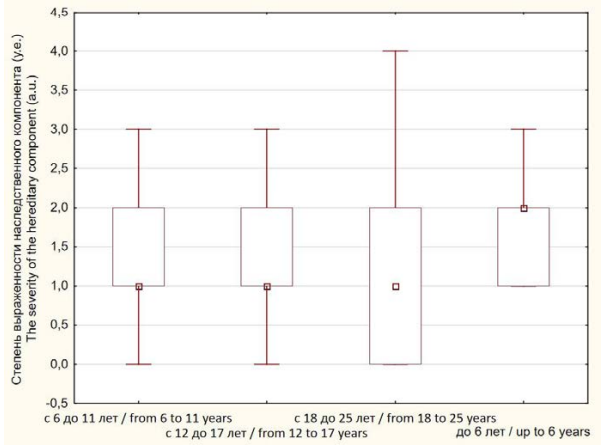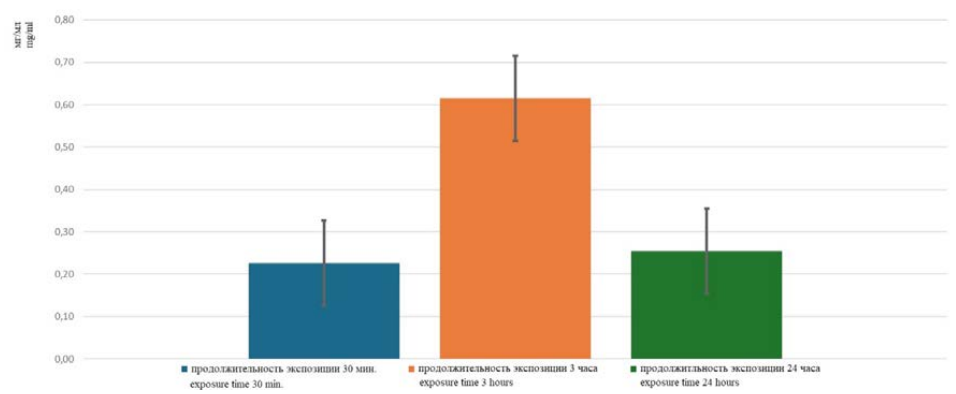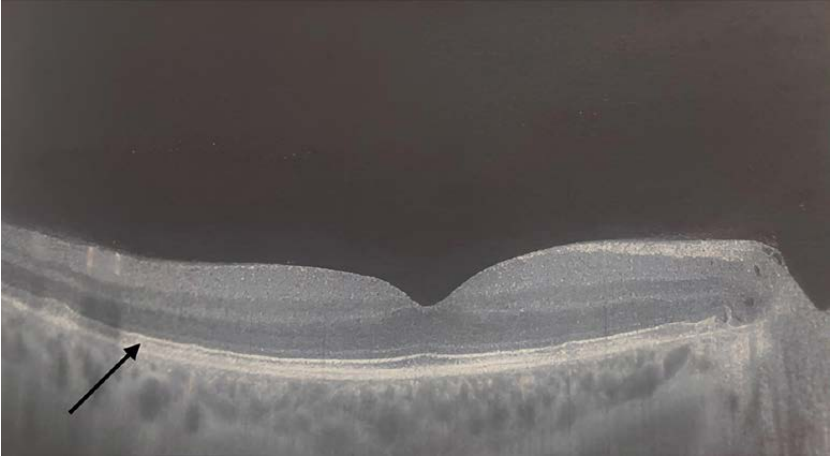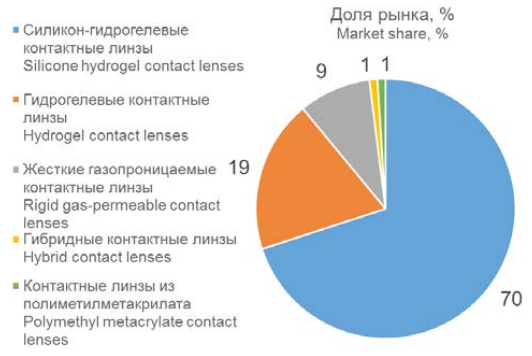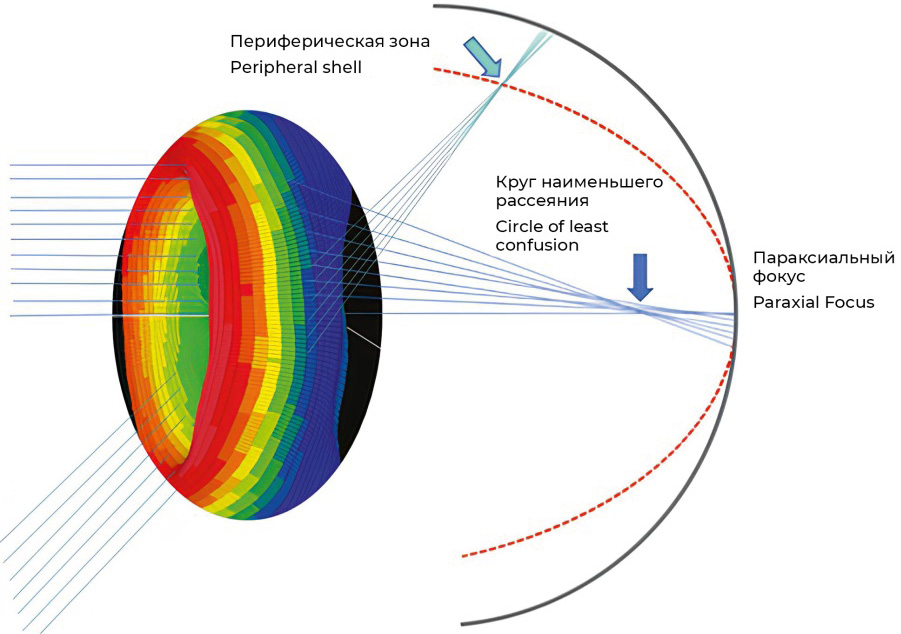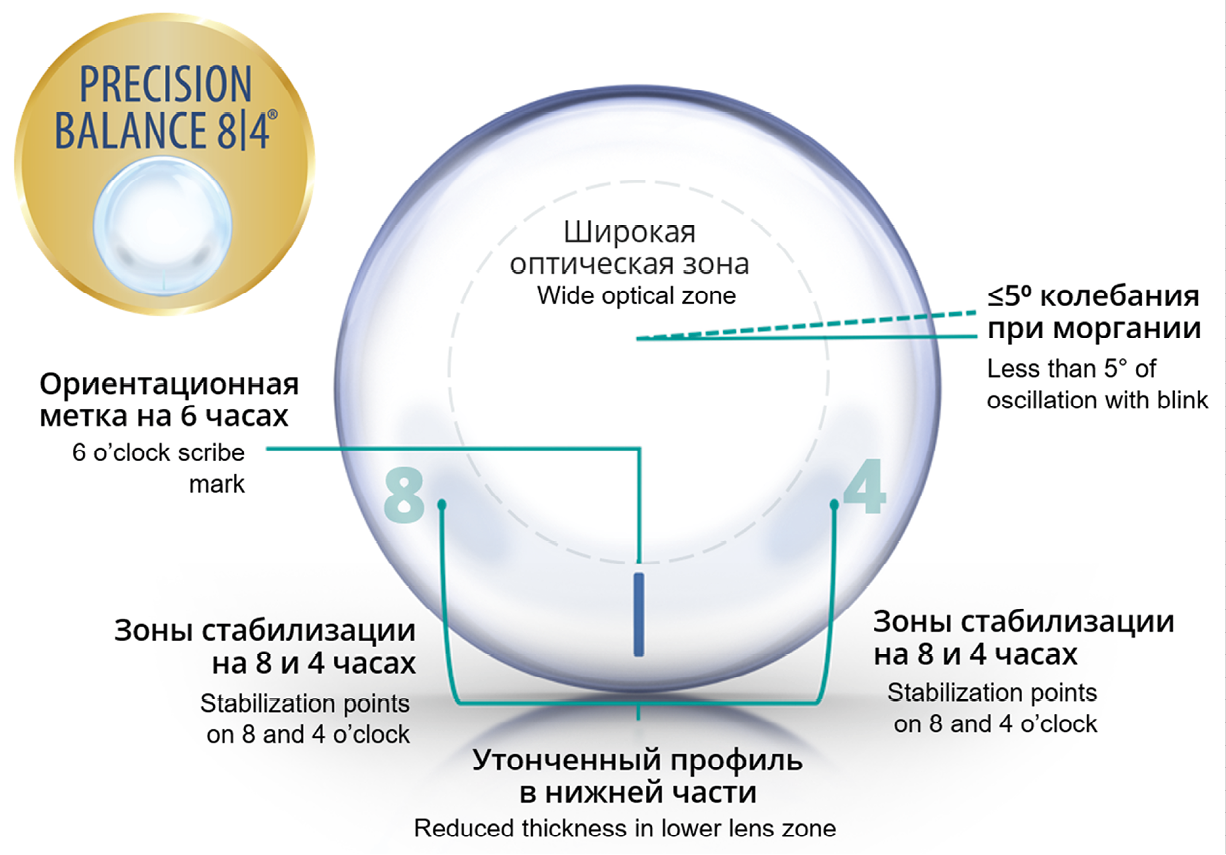ORIGINAL ARTICLES
Background. Orthokeratology has been widely used in Russia since 2002 as a method of correcting refractive errors and effectively controlling myopia progression. However, similar to other contact lens modalities, orthokeratology lenses (OK lenses) may lead to microbial keratitis if proper lens care and handling protocols are not followed. Purpose: to assess the level of patient compliance with medical recommendations, identify key causes of non-compliance, and develop measures to improve adherence. Materials and methods. A questionnaire-based survey was conducted among OK lens wearers and their parents. The study included 101 patients aged 7 to 18 years and 24 parents responsible for lens care and handling. The survey was administered at the end of the first year of OK lens wear. Results. Full compliance with recommendations (adherence to follow-up schedules, wearing, and lens care instructions) was observed in 17.6% of OK lens wearers. Full compliance with lens care routines was reported in 28% of patients, of whom 80.9% had their lens care supervised daily by a parent, while 19.1% were not supervised. The most frequent noncompliance issues included irregular mechanical cleaning of lenses, wearing lenses during episodes of acute respiratory infections, rinsing storage cases with tap water, and washing hands without soap. The rate of full adherence to follow-up visit schedules was 46.4%. Follow-up schedule violations were recorded within the first 1–9 months of lens wear, primarily due to absence of symptoms and lack of time. Conclusions. The findings indicate that OK lens wearers do not always follow recommended care and handling instructions. This underscores the importance of regular parental supervision over lens wear and care in children and adolescents. To reduce the risk of complications and maintain high compliance levels, patients should attend regular follow-up visits. Enhancing compliance requires repeated patient education on lens care practices, organization of online educational webinars for patients and parents, implementation of telemedicine consultations, use of mobile applications for reminders about follow-up visits and hygiene protocols, and demonstration of possible complications via digital devices.
Background. Myopia is one of the most prevalent eye disorders worldwide and can lead to visual disability in young people of working age. The main contributing factors include socioeconomic status, prolonged visual load, and genetic predisposition. However, the sustained near work associated with the educational process makes this condition particularly relevant among university students, including those in medical programs. Long periods of reading, working with electronic sources, laboratory research, and other academic tasks promote the onset and progression of myopia, requiring timely detection and preventive measures. Purpose: to assess the prevalence, structural characteristics, and hereditary component of myopia among medical university students. Material and methods. A questionnaire-based study was conducted from September 2023 to June 2024 among third- to fifth-year students of Orenburg State Medical University, Ministry of Health of the Russian Federation. A complete enumeration sampling method was used. The total sample size included 407 respondents. The questionnaire was based on the REGINA registry tool for patients with hereditary retinal dystrophies associated with confirmed biallelic mutations in the RPE65 and RLBP1 genes, and was supplemented with questions on place of residence, ethnicity, comorbid conditions, disability status, social background, daily visual load, presence and degree of myopia, disease progression, surgical treatment, and age at diagnosis. Results. Myopia was identified in the majority of respondents (56%), with bilateral involvement in 90.3% of cases. Among them, 53% had low myopia, 36% moderate, and 11% high myopia. Myopia onset occurred between ages 12 and 17 in 55% of cases, and between ages 6 and 11 in 30%. The degree of genetic predisposition was not significantly associated with the age at diagnosis. However, a statistically significant relationship (p = 0.035) was found between the strength of the hereditary component and the degree of myopia, with the highest hereditary contribution observed in individuals with myopia of ≥6.0 D. Conclusion. A link was established between parental inheritance of myopia and the severity of the genetic component, which correlates with the degree of myopia. The strongest hereditary contribution was observed in cases of high myopia.
Background. Only a limited number of studies have reported the clinical use of soft contact lenses pre-soaked in non-steroidal anti-inflammatory drug (NSAID) solutions. Within these studies, various soaking durations, drug types, and saturation methods have been proposed. However, a standardized protocol for NSAID loading into contact lenses – taking into account the sorptive properties of the lens material and drug concentration – has not yet been established, underscoring the relevance of the present study. Purpose: to determine the optimal soaking duration for NSAID saturation of soft contact lenses at various stages of desorption. Materials and methods. This experimental study involved the physicochemical assessment of NSAID sorption and desorption from soft contact lenses using high-performance liquid chromatography coupled with tandem mass spectrometry (HPLC–MS/MS). Soaking durations were set at 30 minutes, 3 hours, and 24 hours. The study utilized silicone hydrogel lenses composed of Lotrafilcon A (FDA-approved for bandage use), with 24% water content and a refractive power of –0.5 diopters; a total of 36 lenses were tested. The NSAIDs under investigation were ketorolac tromethamine (30 mg/mL) (hereinafter referred to as ketorolac) and diclofenac sodium (25 mg/mL) (hereinafter referred to as diclofenac), both known for their potent antiinflammatory and analgesic properties. Results. The total amount of ketorolac absorbed by the lenses was comparable after 30 minutes and 24 hours of exposure, with peak uptake (0.61 ± 0.93 mg/mL) observed after 3 hours. For diclofenac, the highest absorption was also recorded at 3 hours (12.0 ± 5.1 mg/mL), which was greater than the concentration of ketorolac. Conclusion. The findings indicate that ketorolac 30 mg/mL enables more uniform saturation of soft contact lenses within clinically relevant concentration ranges, maintaining peak drug levels for up to 24 hours following a 3-hour soak, with minimal alterations to the physical properties of the lenses. In contrast, saturation with diclofenac resulted in a substantial increase in lens mass and exceeded the therapeutic ocular concentration threshold.
Background. Post-traumatic endophthalmitis (PTE) is a severe infectious complication of ocular trauma associated with a high risk of vision loss. In the absence of standardized outpatient prevention protocols for PTE, the selection of an effective topical antibacterial agent remains relevant. Azithromycin, possessing both antimicrobial and anti-inflammatory properties, is considered a potentially effective drug as part of combination therapy. Purpose: to evaluate the effectiveness of topical azithromycin (“Azibakta”) for the prevention of post-traumatic endophthalmitis (PTE) in patients with ocular injuries. Materials and methods. The study included 46 patients with penetrating and non-penetrating ocular injuries, divided into two groups: the main group (n = 23) received azithromycin 15 mg/g (“Azibakta”), and the control group (n = 23) received ciprofloxacin 0.3% (“Ciprofloxacin Renewal”). Both groups were administered standard anti-inflammatory therapy. The primary outcome was the incidence of PTE within 14 days; secondary outcomes included inflammation dynamics and changes in best-corrected visual acuity (BCVA). Results. No cases of PTE were observed in the azithromycin group, whereas three cases (13.0%) occurred in the ciprofloxacin group (p = 0.038). Microbiological cultures performed in these patients identified Staphylococcus epidermidis in two cases—sensitive to vancomycin and gentamicin but resistant to fluoroquinolones—and Bacillus cereus in the third case, a highly virulent, multidrug-resistant organism susceptible to macrolides including azithromycin. These findings support the rationale for azithromycin as a prophylactic agent in high-risk ocular trauma. Azithromycin treatment also resulted in significantly faster reduction of inflammatory signs (corneal edema, conjunctival injection, discharge) and greater improvement in best corrected visual acuity (BCVA), which increased from 0.52 ± 0.38 at admission to 1.24 ± 0.52 at two weeks. No adverse effects were reported. Conclusion. Topical azithromycin administration in patients with ocular injuries reduces the risk of developing PTE and accelerates the resolution of inflammatory symptoms. These findings support its potential as a component of emergency antibiotic prophylaxis for various types of ocular trauma.
Background. Choroideremia (CHM, OMIM 303100) is a rare (1 in 50,000 males) hereditary bilateral retinal dystrophy with an X-linked recessive inheritance pattern. The disease leads to progressive vision loss due to the primary degeneration of the choriocapillaris, followed by progressive atrophy of the retinal pigment epithelium (RPE) and photoreceptors. Female carriers of pathogenic variants in the CHM gene may also manifest clinical symptoms. Purpose: to present the phenotypic characteristics of choroideremia in pediatric carriers of a CHM gene mutation. Materials and methods. This article describes a clinical case of choroideremia associated with a CHM gene mutation in two sisters aged 4 and 2 years. The parents consulted an ophthalmologist due to complaints of reduced distance vision in the elder daughter. In addition to standard ophthalmologic examination, both patients underwent spectral-domain optical coherence tomography (SD-OCT) and electrophysiological testing (ERG). Molecular genetic testing was conducted for diagnostic confirmation and detection of the pathogenic nucleotide variant, preceded by collection of family history. Results. A detailed pedigree analysis and comprehensive examination of biological relatives across three generations confirmed an X-linked mode of inheritance of the disease. Best-corrected visual acuity (BCVA) in both girls was 0.9. The high visual acuity correlated with the preserved foveal architecture observed on spectral-domain optical coherence tomography (SD-OCT), which demonstrated an intact trilaminar structure comprising Bruch’s membrane, the retinal pigment epithelium (RPE), and the external limiting membrane. The ellipsoid zone (EZ), corresponding to the junction between the inner and outer segments of photoreceptors, was absent in the peripheral retina but remained preserved within the foveal region. Electrophysiological evaluation was limited due to the young age of the patients. Molecular genetic testing of family members revealed a previously unreported pathogenic variant in exon 10 of the CHM gene, resulting in a premature stop codon at position 445 (p.Ser445*) in a hemizygous state. This variant is consistent with the molecular characteristics of choroideremia, a form of inherited retinal degeneration (IRD). Conclusion. An etiopathogenetic diagnostic approach and molecular genetic testing enabled the accurate identification of the specific IRD subtype–choroideremia. Pediatric carriers of the pathogenic variant in exon 10 of the CHM gene may exhibit early signs of chorioretinal degeneration, detectable by OCT and ERG.
REVIEWS
Background. The global prevalence of dry eye disease (DED) continues to rise. Alterations in the composition of the tear film are a key factor in the development of this condition. In recent years, a growing body of evidence has emerged on the underlying mechanisms of DED pathogenesis, driven by increasing interest in tear fluid as a material for clinical and diagnostic studies. Purpose: to outline the main research directions concerning tear biomarkers of DED, as well as their role in prognosis, development of novel treatment approaches, and monitoring therapeutic effectiveness. Materials and methods. A literature search was conducted in PubMed for articles published from 2000 to 2024. The selection was carried out using a comprehensive sampling method with the following keywords: tear, dry eye disease, Sjögren’s syndrome, biomarkers, cytokines, oxidative stress, enzymes, extracellular vesicles, microRNAs, NETosis. A total of 60 articles were included in the review. Results. Literature data on tear composition changes in DED indicate the presence of both general inflammatory alterations and disease-specific features. The review summarizes findings on tear content changes involving oxidative stress markers, apoptosis-related factors, proteases and their inhibitors, cytokines, lipids, and nucleic acids. Tear hyperosmolarity is a hallmark of DED, contributing to the enhancement of inflammation, recruitment of neutrophils into the tear film, and the formation of neutrophil extracellular traps (NETs). Elevated levels of inflammation markers such as matrix metalloproteinase-9, lactoferrin, myeloperoxidase, and elastase are indicative of disease severity. Differences in tear composition between Sjögren-related and non-Sjögren DED have diagnostic potential. Furthermore, tear microRNAs show promise as severity markers and differential diagnostic tools in DED. Conclusion. Available literature convincingly demonstrates that tear components can serve as biomarkers for diagnostic, prognostic, and therapeutic monitoring purposes in dry eye disease. The investigation of DED biomarkers paves the way for personalized approaches to the treatment of this condition.
Background. The global and Russian contact lens markets are experiencing dynamic growth, encompassing several distinct classes of lenses that differ in structure and properties. However, Russia currently lacks domestic base materials for the manufacturing of contact lenses. This highlights the relevance of reviewing the available literature on lens production methods and the primary chemical materials used in their fabrication. Purpose: to identify the material structures used in contact lens manufacturing and to analyze the advantages and limitations of each class of materials. Materials and methods. A literature review was conducted involving 29 scientific publications focusing on contact lens fabrication techniques. The review highlights materials that have significantly influenced the development of the industry or have reached the commercial market. Results. This review traces the historical development and current trends in the use of various materials for contact lenses, including glass, polymethyl methacrylate (PMMA), hydrogels, and silicone hydrogels. It outlines the molecular structures of these materials: hydrogel lenses are typically composed of copolymers such as hydroxyethyl methacrylate, N-vinylpyrrolidone, N,N-dimethylacrylamide, and other organic monomers. Silicone hydrogel lenses incorporate these hydrophilic components along with silicone oligomers. Glass and PMMA lenses are characterized by excessive rigidity, making them uncomfortable for everyday wear. In contrast, hydrogel lenses provide more appropriate elasticity but fall short in delivering sufficient oxygen to the cornea. The primary focus of the review is on silicone hydrogel lenses. These materials are considered safe due to the bioinert nature of silicones. Ongoing research is directed toward improving the compatibility between hydrophilic and hydrophobic domains, refining the architecture of silicone macromers, enhancing surface modification techniques, and exploring new manufacturing methods. The article also examines four generations of commercially available silicone hydrogel materials and highlights an emerging direction in the field: biomimetic lenses based on methacryloxyethyl phosphorylcholine – a compound that closely mimics the structural characteristics of natural tissues. Conclusion. Compared to previous lens generations, silicone hydrogel lenses represent the most advanced class of materials to date. They offer superior comfort and are best suited for extended wear due to their optimal moisture retention, oxygen permeability, and elasticity. An emerging area of interest is the development of biomimetic contact lenses made from tissue-like polymeric structures.
TECHNOLOGIES
This article examines the extent of orthokeratology lenses for myopia control vs myopia management in children. The authors discuss design options for Ortho-lenses and conclude, based on clinical studies, that not all Ortho-lenses are suitable for myopia control; most designs may be applicable for myopia correction only.
WORKSHOP
Astigmatism is one of the most common causes of reduced visual quality, especially under conditions of digital visual strain. Despite its high prevalence, astigmatism is not always corrected with astigmatic spectacles or contact lenses. This article discusses the advantages of soft toric contact lenses in improving visual function and reducing symptoms of digital eye strain (DES). It presents clinical research data and real-world practice examples. Special attention is given to modern toric lens designs and their impact on visual stability and wearing comfort.
MEDICINE AND LAW
NEWS: WHAT? WHERE? WHEN?
ISSN 2686-8083 (Online)



